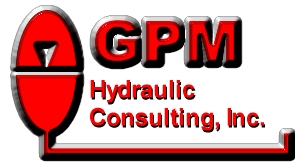
P.O. Box 1376
Monroe, GA 30655
(770) 267-3787
gpm@gpmhydraulic.com
 |
 |
 |
 |
 |
 |
November 2013
For an archive of past newsletters, please visit:
http://www.GPMHydraulic.com/newsletter_archive/
"Troubleshooting Hydraulics" Newsletter
www.gpmhydraulic.com
1. Line Sizing for Maximum Efficiency
2. Call GPM For Emergency Troubleshooting
3. Our NEW Accumulator Safety DVD
4. Is It Time For A Hydraulic Reliability Assessment At Your Plant?
5. Parts Changer or Troubleshooter? Take the Quiz!
6. 2013 Hands-On Public Reliability & Troubleshooting Workshops
OK, so you've done everything your OEM has recommended and your machine still overheats, it's still louder that you think it should be, the hoses still jump more than you would expect them to, leaks still develop and the current draw at your drive motor is still higher than that of similar (or even smaller) machines. What's left? More often than you might think, it can be your line sizing. Particularly if there have ever been any modifications to your machine over the years, but I have also found undersized hydraulic lines in machines that have remained exactly as they were installed. Selecting the proper line size for a hydraulic system is critical for maximum performance and machine life.
Why is line sizing so important? Because heat and turbulence are generated as the oil moves through the system. This is compounded by the number of bends in your pipe and what bend radius is used. I most often find improper line sizing when a portion of the lines are provided by the manufacturer and another portion is provided by the customer. Whenever a bend or "T" can be avoided, it should be.
Usually, when pipes are straight, turbulence only becomes an issue when the pipe is too long. When all of the molecules of oil are traveling exactly parallel to each other, we have a condition known as "laminar" flow. The oil near the walls of the pipe or hose will move somewhat more slowly than the oil in the center due to friction against the walls of the pipe. But so long as the molecules remain parallel, this is not much of a problem. The trouble comes when the oil encounters some sort of obstruction or change in direction. This causes our laminar flow to become turbulent. Much of the energy that is applied to the machine by the drive motor must be wasted to regain our laminar flow. The higher the fluid velocity, the bigger this problem becomes.
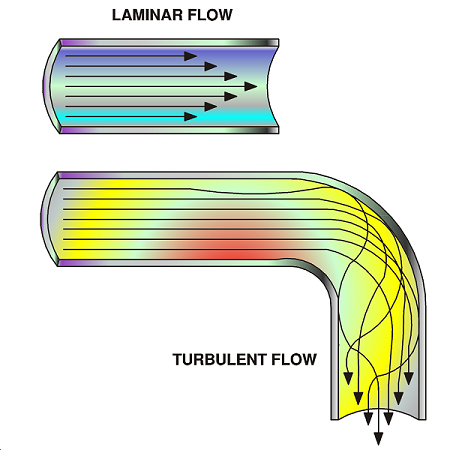
Fluid velocity can be calculated by dividing the flow by the area of a cross section of the conductor. If we are measuring flow in gallons per minute and velocity in feet per second, the formula is:
Thus, we can reduce the velocity (and the associated turbulence) by either decreasing the flow or increasing the size of the pipe or hose. The size pipe we will use is determined by its purpose, i.e. suction, return or pressure line. For most hydraulic systems, we like to keep the velocity in the suction line between about 2 and 5 feet per second. We like the velocity to be very low in a suction line so it is easy for oil to enter the pump. There should be very little resistance in a suction line because anything that makes it hard for oil to get into the pump can cause it to cavitate. Velocity in the return line can be a little higher, so our target is between 10 to 15 feet per second. In pressure lines, so long as we are operating below 3000 PSI, we want the velocity somewhere between 15 and 20 feet per second. Most industrial machines operate below 3000 PSI, but many operate well above that. In machines that operate above 3000 PSI, usually there are no customer-provided lines, a lot of design attention is paid to the number of bends and the size of the bend radii so that fluid velocity can be at 30 feet per second and above, thus avoiding the use of exceptionally large pipes.
The schedule of pipe plays a factor, too, because higher schedule pipes have thicker walls to accommodate higher pressures. Thus two different schedules of pipe may have the same outside diameter, but different inside diameters. To properly size hydraulic pipes, a pipe chart must match the schedule of pipe in use.
In general, we use schedule 40 pipe for suction and return lines and schedule 80 or 160 for pressure lines. Below is a schedule 40 pipe chart:
Let's say we are sizing a suction line for a system that uses a 30 GPM pump. Since we want the fluid velocity at or below 5 feet per second, we would look down the 5 feet per second column and find 30 gallons per minute. We see that it jumps from 23.4 to 31.9 GPM. This will usually be the case on a pipe chart, so always go with the next higher pipe size, not the lower. This tells us that a 1-1/2" schedule 40 suction line can handle up to 31.9 GPM without generating excessive turbulence.
Similarly, sizing a return line, we see that a 1" schedule 40 return line can handle up to 40.6 GPM.
To size a pressure line below 3000 PSI, we must use a schedule 80 pipe chart.
On the schedule 80 chart, we see that a 1" schedule 80 pipe can deliver up to 45 GPM.
It's pretty easy to tell if you have excessive turbulence in your lines. If your lines are wasting energy, you can hear and/or feel it. Listen at any of your fittings, bends and "T's". Feel for heat or use a temperature gun or infrared camera to see if you find hot spots. If you do, chances are that your pipes or hoses are undersized.

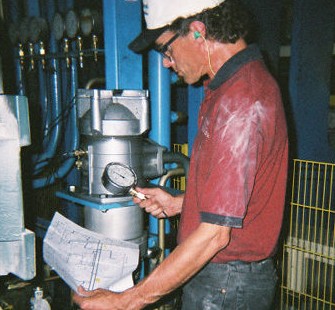 | 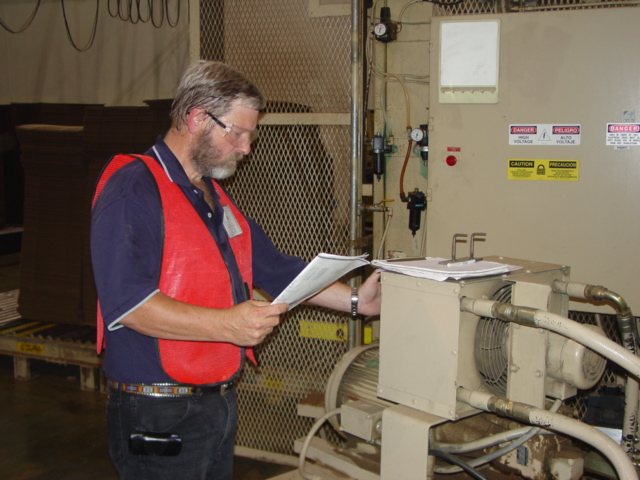 | 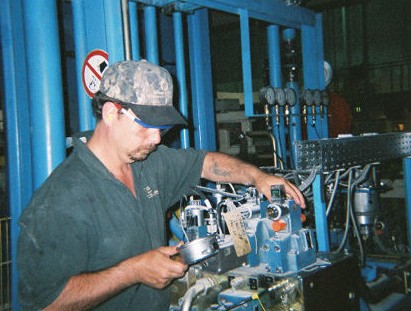 |
Nothing is more expensive than unscheduled down time. GPM’s customers know they can call whenever they have a troubleshooting issue they simply can’t resolve. With over 75 years' experience dealing with hydraulic failures, our consultants have the resources to help troubleshoot whatever hydraulic problem you encounter. Whether you’re experiencing a total system outage, repeated component failure or need a professionally designed hydraulic reliability assessment, the consultants at GPM can help. Call GPM for:
- In-plant Troubleshooting
- Leakage Problems
- Pressure Settings
- Shock Problems
- Hydraulic Reliability Assessments
- Hydraulic Troubleshooting Manual Development
- Startup Consulting and Recommendations
- Heat Problems
- Repeated Component Failures
- Speed Problems
Do you want to learn more about how GPM can help you? Go to http://gpmhydraulic.com/troubleshooting.php.
5 ripe avocados Cut avocados in half. Scoop pulp into a bowl, and mash with a potato masher or fork until slightly chunky. Stir in chopped red onion and next 4 ingredients. Cover with plastic wrap, allowing wrap to touch mixture (no air pockets - this keeps it from turning brown), and let stand at room temperature 30 minutes. Serve guacamole with tortilla chips. |